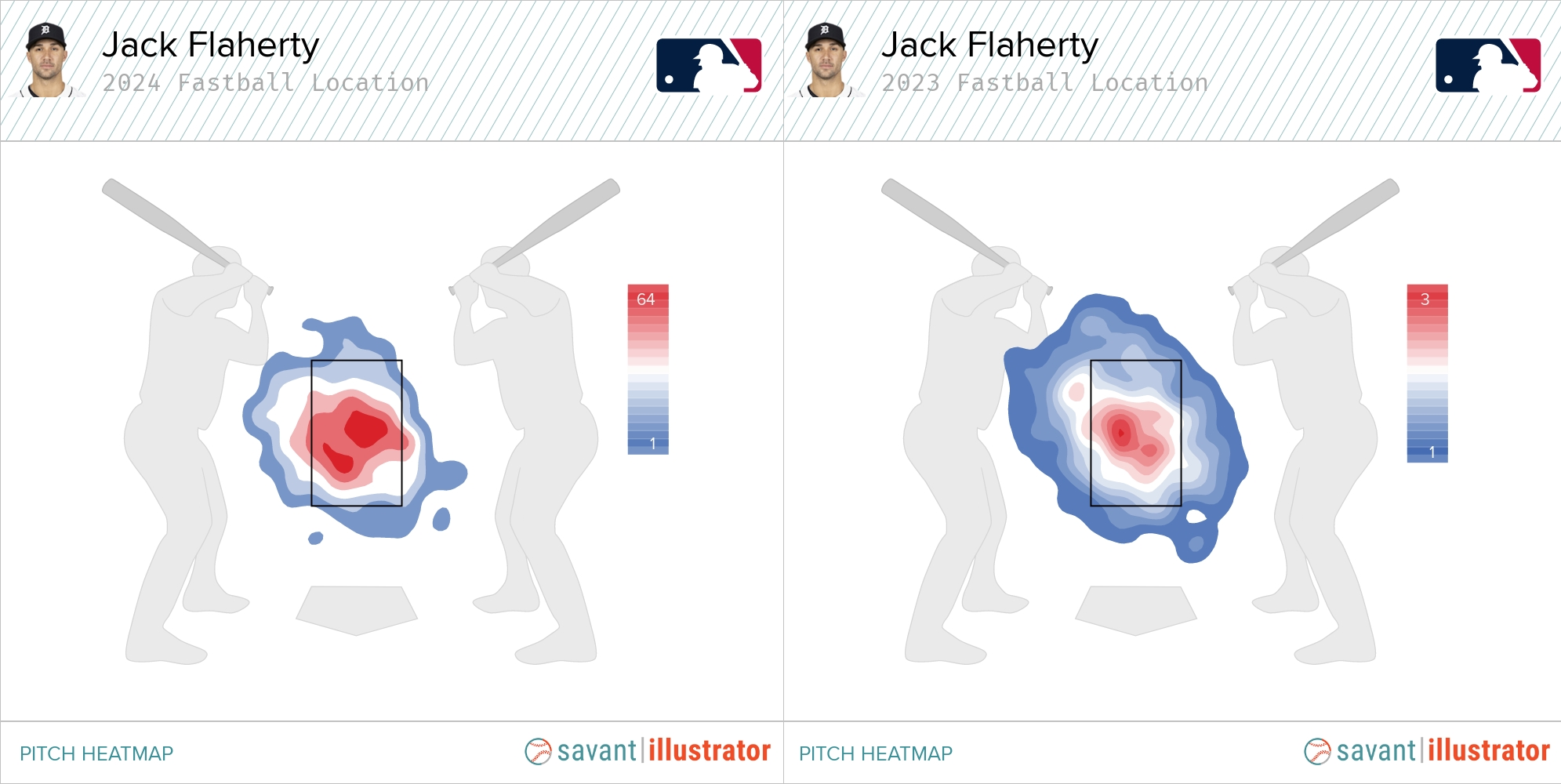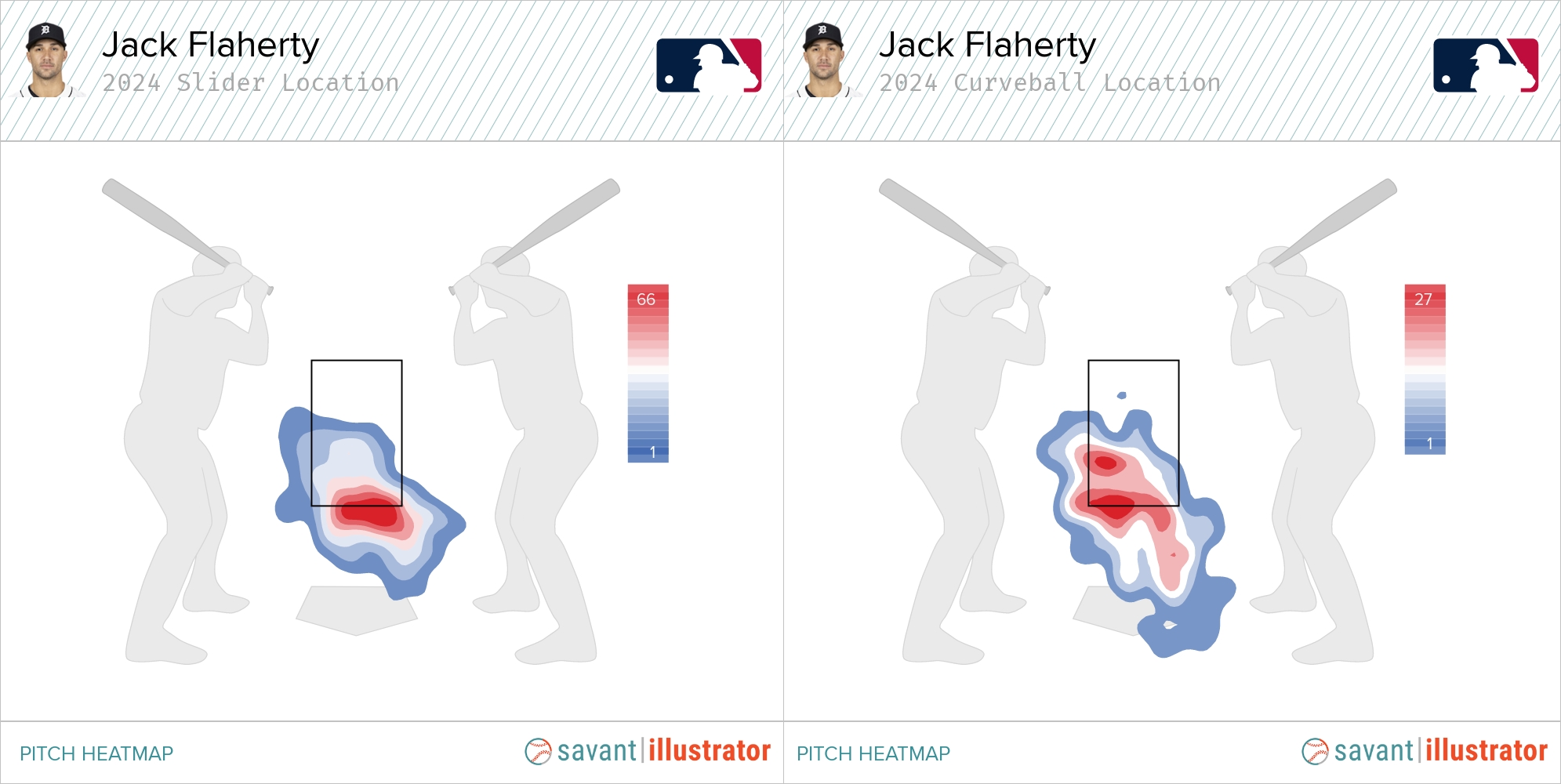When Jack Flaherty signed a one-year, $14M “prove-it” contract with the Tigers in December, I don’t think many people anticipated this kind of turnaround.
Last year, Flaherty continued his struggles with the Cardinals before being shipped off to Baltimore at the deadline and struggled heavily with the Orioles. Most assumed Flaherty was another once-promising starter who flamed out due to injury.
He’s been nothing short of incredible in 2024. Though his 2.3 fWAR only places him as the third-best starter in Detroit, he ranks 26th among all starters and, under the hood, looks even better. Through 100.2 innings, Flaherty has a 3.13 ERA, 0.96 WHIP, 32.4% K%, and 4.3% BB%. Outside of ERA, all would be career bests. He’s also missing more bats than ever, and his 32.8% CSW% would also be a new career high. Given his exceptional peripherals, his ERA doesn’t tell the full story: his 2.61 SIERA and 28.1% K-BB% both rank second in baseball behind Garrett Crochet.
Not only are the career-best numbers eye-popping, but it’s the sheer level of turnaround that Flaherty has exhibited. He’s increased his K-BB% by 15.8% compared to last year, which is nearly double the 8.8% improvement by second-place Sonny Gray. Not only does it stand out this year, but it’s one of the biggest recent shifts from a starting pitcher.
Since 2000, only three starters (min. 40 IP starting) have posted a bigger improvement in K-BB% than Flaherty has this year. That’s out of 3237 individual pitcher seasons.
Giolito and Cease’s inclusion on this list is worth a story on its own (those White Sox teams did some damage, right?), but that’s for a rainy day (or every day as it may be for a White Sox fan).
Why is K-BB% important? It’s one of the most informative stats about a pitcher’s performance. Previous research has suggested that K-BB% can out-predict other ERA estimators such as FIP and SIERA.
Flaherty’s 28.1% K-BB% this year is the best we’ve ever seen from him, and it’s even better (albeit by 0.5%) than his historic 0.91 ERA second half in 2019. The most curious part of Flaherty’s return is that nothing in particular screams breakout. As Jack Foley wrote in May, Flaherty’s start didn’t seem sustainable, but the stuff seemed to be working.
What stands out is a slight increase in velocity and improved command. While individually, neither of these improvements has previously been significant for Flaherty, the combination of both is fueling his resurgence.
Velocity Always Matters, No Matter the Pitch
Flaherty’s collective arsenal is up half a tick, a sure sign of health that has improved effectiveness across the board.
The fastball now sits around his career average and has added two inches of ride compared to last year. From a 5.5 ft. release height, Flaherty’s 15.3 inches of induced vertical break (iVB) is slightly above average. The core location of fastballs hasn’t changed (more on that later), but Flaherty has improved his fastball whiff rate from a league-average 20.8% to 25.0%, which is in the 81st percentile.
While the fastball was a return to a career norm, Flaherty’s main breaking pitches have both gone to the upper bands of velocity. Flaherty’s throwing his slider at almost 85 mph, the hardest in his career, and his curveball at 77.5 mph, the second-hardest in his career. There hasn’t been a tradeoff in movement either; both pitches are getting similar amounts of horizontal break as last year with minimal losses in drop.
A healthy Flaherty is a good one, and the ball is zipping out of his hand right now. That gives him the confidence to put competitive pitches near the zone, which he is excelling at.
Command Freak
The pitches themselves have taken a step forward, but what has made Flaherty so effective is primarily their location. The fastball command has honed in on the strike zone, while the slider and curveball are sitting in a picture-perfect spot.
Starting with the fastball, Flaherty has attacked the zone more than ever. His 57.6% zone rate is the highest of his career and in the 90th percentile among starters. The difference from previous years is the sheer spray of locations.

More strikes are great, but the lack of waste pitches truly is phenomenal from Flaherty. He’s thrown just 2.7% of his fastballs in the waste zone, down from 6.7% last year and 5.0% for his career. Furthermore, Flaherty is working east and west and is able to consistently nibble the corners. Flaherty is now rocking a 23.3% called strike rate on the fastball, which is 95th percentile.
Flaherty is getting a cumulative 34.9% CSW% on his fastball, which is the best in baseball.
As for the breaking pitches, Flaherty has established the shadow zone better than any other pitcher. 36.7% of his sliders and curveballs are located there, which is the second most out of any pitcher (min. 150 breaking pitches).

I don’t even need to share any more numbers about it. Living at the bottom of the zone like that is quite literally as good as command gets. Flaherty is getting whiffs galore from both pitches: the slider has a 39.1% whiff rate, and the curveball has a 44.5% whiff rate.
The locations being so close to the zone leads to high chase rates but also lends itself to getting called strikes as well. Both pitches post slightly below average called strike rates, but that’s impressive when both pitches are thrown in the zone around 30% of the time. Flaherty’s also stolen a handful of calls, too: his 23 out-of-zone called strikes on breaking pitches lead all of baseball. He’s gotten help from Jake Rogers behind the plate, one of the best low-pitch framers in baseball this season.
Flaherty’s dialed in his entire arsenal around the strike zone and also improved it from last year’s struggles. By throwing strikes and toeing the line of the zone, it’s easy to see how Flaherty’s kept his strikeouts up and his walks down. The most impressive part is how well he’s sustained his K-BB rate and velocity. Though he has battled through a back injury, Flaherty will continue his redemption tour throughout the year and hopefully be rewarded with a nice payday.
